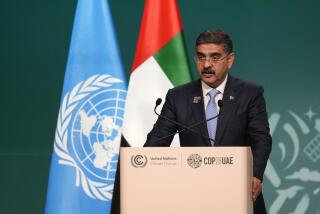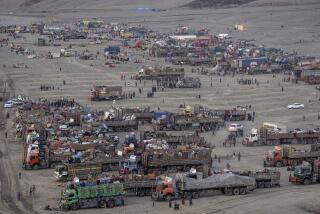The Taliban Takes Cover in Cities, Mountains
- Share via
PESHAWAR, Pakistan — As American bombs slammed into Afghanistan for a seventh day Saturday, fighters of the ruling Taliban have taken cover in the mountains or in heavily populated urban areas, according to refugees and the extensive military intelligence network here in neighboring Pakistan.
In fact, city centers are sufficiently tranquil that large numbers of regular Taliban have brought their small arms with them, these sources say.
However, many Afghans fleeing to this border town--most of them ethnic Pushtuns, the same ethnic group that makes up the majority of the Taliban--also say the attacks have strengthened, not weakened, internal support for the regime.
On the ground, the assessment of the intensive U.S.-led aerial campaign jibes with the official American position: The strikes have effectively destroyed high-profile military targets, including airports, communication facilities and antiaircraft positions.
A Pakistani air force intelligence officer who spoke on condition of anonymity said: “Our initial assessments suggest that the Taliban are totally dysfunctional as a military force. The airports are dysfunctional, their strategic assets are dysfunctional. However, they retain small assault weapons, mines, shoulder-fired missiles [and] rocket-propelled grenades that can be used in guerrilla warfare.”
But refugees, foreign aid workers and the Pakistani intelligence sources say the damage has come at the price of some civilian casualties--and perhaps a propaganda setback as well.
“Earlier, before the attacks, most people were repulsed by the Taliban’s oppressive policies,” said Ahmadshah Shakeer, who left the capital, Kabul, on Thursday after retrieving his aging mother from the city. “The airstrikes have brought them sympathy and more support than they’ve had in years--not just in Afghanistan but throughout the Muslim world.”
Yet Shakeer, who resigned his job as head of the Herat city building department two years ago and left Afghanistan out of disgust with what he terms Taliban narrow-mindedness, said less than half the shops in central Kabul remain open. He said he found government offices open but largely unmanned.
“If you go to the passport office for a form, you won’t find anyone to give it to you,” he said. “It’s really obvious there is a state of war.”
The Taliban claims that so far more than 300 civilians have been killed in the American attacks, including 200 in one village near Jalalabad, but these numbers have not been verified independently.
But despite the nightly attacks, foreign aid workers report that some routine activities continue--although on a diminished scale--in Afghanistan’s main cities, which were already hardened to combat after more than two decades of civil war and anti-Soviet resistance.
Likewise, according to Afghans living in Pakistan who talk regularly with their families in Kabul, people remain relatively calm through the nightly attacks, most of which have taken place in the outer suburbs of the city.
“My father said that when the bombing happens the people just come out and watch like it’s a show,” said an Afghan who works as a waiter in Pakistan’s capital, Islamabad, and who telephones his family members every day to check on their safety.
The waiter, who did not wish his name to be used, said the phone lines from Pakistan to Kabul are clear and dependable. He said his family members avoid political discussions during calls out of fear the lines might be tapped.
Although he opposes the Taliban regime, he begins each call with a mention of “our Taliban brothers.”
Afghans have known little but war since the 1979 Soviet invasion, but the U.S. airstrikes, witnesses say, are of another magnitude.
“Afghanistan has never seen so many military aircraft,” Shakeer said. “They are using very heavy bombs, heavier than we have ever felt before. Everyone is very frightened.”
Indeed, the bombing has accelerated the migration of displaced persons, both inside Afghanistan and outside the country.
Among them was Fazel Rehman, a 31-year-old truck driver lying Saturday in a Peshawar hospital bed where he was being treated for wounds suffered three days earlier during a U.S. air attack on his village near Jalalabad, Afghanistan.
“The whole house collapsed,” he said.
Rehman’s misfortune was that he lived too close to a former Afghan resistance stronghold in an area where U.S. intelligence had identified several possible sites of terrorist training camps.
Since then, members of Rehman’s family have fled their home village near Jalalabad for the northern province of Konar, where they will stay with relatives at least until the bombing stops.
Rehman said he was initially treated at a 28-bed hospital in Jalalabad but was asked to leave after 36 hours because his injuries were not considered serious enough for him to occupy a badly needed bed. His family provided him with bus fare to make the 40-mile trip to the Pakistani border, where he was transferred to an ambulance for the remainder of the journey to Peshawar.
Although Pakistani authorities are allowing wounded refugees to enter the country, they are stopping many others.
Shakeer, for example, first tried to bring his mother through the Taliban stronghold, Kandahar, and then to Quetta across the border, but he was refused entry by Pakistani border guards and blocked again at another crossing. He said he finally bribed his way through a small border checkpoint with a payment of less than $1.
Despite the bombing, United Nations World Food Program convoys have continued delivering grain--most of it American--to warehouses in Kabul. Two separate convoys, one consisting of 40 trucks, another of 37, delivered a total of 2,000 tons of grain Friday and Saturday.
The bombing also has not disrupted Kabul’s irregular electricity supply, which even before the attacks was limited to a few hours a day. Because gasoline remains available, the capital’s boxy yellow taxis still ply the roads.
Some Kabul schools remain open, including a 2,500-student facility operated by the U.S. charity Save the Children.
According to Pakistani intelligence sources, one of the buildings in Kabul that has been targeted by American aircraft houses the Defense Ministry and is said to have been used as a military headquarters by Osama bin Laden’s Al Qaeda terrorist network.
Al Qaeda, which allegedly conducts terrorist operations overseas, is made up primarily of foreign fighters who are part of the military forces within Afghanistan.
“There used to be so many Arabs in this building that it gave the impression of being a government office in an Arab country,” one Pakistani official said. “There is nothing left now.”
Refugee sources said that American cruise missiles also knocked out the broadcast building for Kabul’s radio and television. The national Radio Sharia broadcasts, used by the Taliban leadership to announce its draconian religious edicts, was knocked off the air for a day before resuming service from a facility in the northern city of Mazar-i-Sharif.
The situation in Mazar-i-Sharif, said the Islamabad director of an international humanitarian group, is more tense than in Kabul. Mazar, now in Taliban control, has changed hands several times in the civil war between the mainly ethnic Pushtun Taliban and the minority Tajik, Hazara and Uzbek opposition force, the Northern Alliance.
Emboldened by the U.S. attacks, the Northern Alliance is said to have set its sights on the city.
“People are scared in Mazar,” said the humanitarian group’s director. “The city itself has not been attacked, but there is concern that if the Taliban leaves, it will create a vacuum of power and there will be looting and plundering.”
The Pentagon acknowledged Saturday that a U.S. bomb had missed its intended target in Kabul and hit a residential area. But anecdotal information suggests that many civilian casualties have stemmed from the collapse of poorly built homes and other structures in the vicinity of targets.
The structures apparently crumble under the shock waves created by the large bombs being used in the campaign.
Rehman, who suffered serious injuries to his left arm and right hand, related how he and three other men dug themselves out of the rubble of the village guest house where they were spending the night.
He spoke of other injuries and some deaths in the village after residents had been trapped in their collapsing homes.
Fauzia Nabi, about 35, sat at the Khyber Hospital in Peshawar on Saturday after arriving from Kabul with her young daughter Farida. She said her husband was killed when their house collapsed during an air raid, while Jan Mohammad, a 25-year-old clerk for the Danish aid agency DACAAR’s Jalalabad office, said he had seen several houses in his home village, about 10 miles north of the city, crumbled.
Some civilians have also been killed by errant direct hits, such as the four employees of a United Nations-affiliated mine clearance organization who died early last week when the group’s office in Kabul was hit.
Mohammad said there was far less damage in central Jalalabad, although the city was clearly emptying out as frightened residents feared the worst.
“The only people still there are those too destitute to leave,” he said. “Most shopkeepers have closed up, taking what they can with them.”
*
Tempest reported from Islamabad and Marshall from Peshawar.
More to Read
Sign up for Essential California
The most important California stories and recommendations in your inbox every morning.
You may occasionally receive promotional content from the Los Angeles Times.













